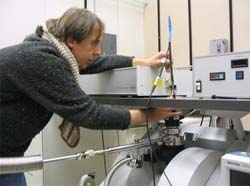Quantum computer - 18 billion billion times faster, is it realistic?
Do you want your computer to run 18 billion billion times faster?
According to a physicist at the University of Utah, the future is likely to have a new type of computer - quantum computer. He took the first step in his plan to create that computer.
This type of computer enhances the use of quantum bits (qubits), uses binary 1 and 0 at the same time but differs from position. In quantum physics, the smallest particles of light and matter can be in many different locations at the same time (such as particles of sunlight, water particles .).
For today's computers, an electronic bit (binary number) can only be in one of two states: 1 (off) or 0 (open). If there are 3 bits, they can store one of eight matching cases of 1 and 0: 1-1-1, 0-1-1, 1-0-1, 1-1-0, 0-0-0 , 1-0-0, 0-1-0 and 0-0-1.
But quantum computers can store all eight cases. Theoretically, a 3-qubit computer can calculate eight times faster than a 3-bit PC. According to this calculation, a 64-qubit computer can calculate 2 to 64 times faster than a 64-bit PC, meaning faster than 18 billion, billion times.
 Quantum computer - 18 billion billion times faster, is it realistic? Picture 1
Quantum computer - 18 billion billion times faster, is it realistic? Picture 1
Boehme is working on a quantum computer reading technology
Physicist Christoph Boehme, assistant professor of physics at the University of Utah, has read archival data in the form of a magnetic "spin" of a group of thousands of phosphorus atoms. " We have demonstrated experimentally that the nuclear rotation direction of phosphorus atoms embedded in silicon solution can be determined by a lot of microelectronic currents passing through the atoms, " he said.
" We have solved a major obstacle when successfully building a specific type of self-quantum computer: phosphorus and silicon quantum computers. With this concept, readable data is the biggest problem, and we have shown the way to read new data ".
The mechanism of the operation of a quantum computer has appeared before, by the Australian physicist Bruce Kane in the article: " A silicon-based nuclear spin quantum computer " ( Quantum computer turned silicon-based nuclei). Silicon, semiconductors used in digital computer chip technology will be "released" into phosphorus atoms. The data is encoded in the "revolutions" of the atomic nucleus. Extensive applied electric fields will be used to read and implement the data storage process as "revolutions". Boehme confirmed that it is possible to read the rotation of single phosphorus atoms in a technical way.
This physicist has been studying quantum computers for years. "If you compare the development of quantum computers with traditional classical computers, it can be likened to being in a period before we find a radius. All that is just the beginning. only ".
But its machine-brain interface is billions of times slower.
Like the Hitachi research firm once pointed out, people can control the on / off switch simply by thinking about it. Optical region techniques are used to determine changes in the total amount of blood in the cerebral cortex before people are doing certain activities such as thinking about arithmetic operations or imagine singing a song. The technique of determining changes can turn on / off the railroad model.
The optical zone uses infrared light to penetrate the upper level of the cortex and then radiates back. Thanks to this radiation ability, the amount of blood changes and the level of hemoglobin concentration in the brain is measured. It all takes only a tenth of a second.
Hitachi hopes this technique will lead in the field of medical brain machine interface, which is helpful for physically impaired patients. The company also hopes that the practical results can help this product be marketed in 2011, decades before quantum computers can be built. But everything is subject to change. We cannot know for sure.
You should read it
- What is quantum computing and how did people develop this technology?
- The concept of PC will be replaced by QC
- New chip technology can enhance quantum computing
- The difference between quantum computers and supercomputers
- Quantum computing will become Amazon's key business service
- What is silicon Valley?
- Improve the safety of quantum computers at an unprecedented level
- Is it possible to hack a Bitcoin wallet with a quantum computer
- Getting the light to stop, an important step to making quantum computers
- Ordinary things in Silicon Valley but strange to the rest of the world
- Quantum computing - a marathon, not a sprint contest!
- Microsoft developed a new programming language for quantum computers






 China's quantum computer is 180 million times faster than a supercomputer
China's quantum computer is 180 million times faster than a supercomputer New chip technology can enhance quantum computing
New chip technology can enhance quantum computing Intel challenged IBM and Google with supercomputers with 250 times cooler temperatures than the universe
Intel challenged IBM and Google with supercomputers with 250 times cooler temperatures than the universe The concept of PC will be replaced by QC
The concept of PC will be replaced by QC Is Firefox Quantum faster than Chrome? This is a detailed test result!
Is Firefox Quantum faster than Chrome? This is a detailed test result! Opera 51 is 38% faster than Firefox Quantum, download and experience
Opera 51 is 38% faster than Firefox Quantum, download and experience